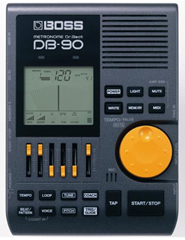Musician 101: Developing an Internal Pulse
In this post we hope to give musicians some ideas/exercises to improve on internal pulse. Keeping a steady pulse is a fundamental skill for any musician. Even in different charts that encourage a flexible rhythm, such as a passage marked rubato, being able to maintain a steady pulse is essential for the music to work.
One common cause of tempo problems is a musician’s inability to keep an accurate internal pulse. To keep a steady beat we must be able to feel the beat aka pulse. Having a precise sense of rhythm is the result of not only of an understanding of rhythm, but a finely honed physical sense of pulse as well.
 To do these exercises you will need a metronome. Metronomes are available as apps (some for free), inexpensive digital and some very nice analog models. The best metronome I have ever used is the Boss Doctor Beat DB-90. I had a recent nasty solo in Holst’s Venus that had me playing on the beat while most of the band played on the off beats. To practice for that I set the Dr. Beat to ping on one and beat on the upbeats. Very cool exercise and one that I attribute to the piece not getting pulled from the concert.
To do these exercises you will need a metronome. Metronomes are available as apps (some for free), inexpensive digital and some very nice analog models. The best metronome I have ever used is the Boss Doctor Beat DB-90. I had a recent nasty solo in Holst’s Venus that had me playing on the beat while most of the band played on the off beats. To practice for that I set the Dr. Beat to ping on one and beat on the upbeats. Very cool exercise and one that I attribute to the piece not getting pulled from the concert.
EXERCISE 1
Here’s what I do with all scales, arpeggios etc. I’m working on across the full range of the instrument:
- Put the metronome on 40 (a little more is fine, but not more than 60)
- Play each note in the scale as:
- Whole notes
- half notes
- half note triplet
- quarter note
- quarter note triplet
- 8th notes
- 8th note triplet
- 16th notes
- 16th notes triplets
- 32nd notes
- 32nd note triplets
(Don’t feel you have to go up to 32nd notes unless your are at an advanced level. Even working on the first 5 or so will make a huge difference.)
Not only do you get to work on your scales, but you force yourself to work on feeling the divisions of the beat.
EXERCISE 2
- put your metronome on 40-60 bpm
- clap on the beat of the metronome.
- If you clap is right on the beat, the sound of the click of the metronome will “disappear”.
- Then you try to go as long as you can without hearing a click
- You may only get one or two beats to disappear at a time, but with practice you could work up to longer and longer between hearing any click.
EXERCISE 3 ~ requires a friend
- Put your metronome on whatever medium tempo speed you would like. (or on 2&4).
- even if you do it with a 1 octave scale, play constant notes – pick your note length (1/4 notes or 8th notes work best)
- have your friend mute / spin the volume to ZERO while you keep playing
- you friend will then bring back the metronome.
- obviously if the metronome comes back in and you are still in time with it, you are doing good.
- With some practice, this might help you let go of the metronome and trust your internal metronome more.
Exercise 4
Pick a 4/4 medium, medium-up tune. I would assume this works with straight tunes as well, but thus far I’ve only used this exercise with swing tunes.
1) Put the metronome on 2&4.
2) Add a repeat to the end of the tune and play it over and over and over until you know the tune quite well.
3) Now, in your mind, make the last measure of the tune a 5/4 bar. This will essentially flip the time every other time down the form ON PURPOSE.
1st time – you’ll be playing on 2&4
2nd time – you’ll be playing on 1&3
3rd time – 2&4
and so on….
4) when you are really comfortable flipping the time at the end of the form, start adding – or taking away beats to purposely flip the time several times throughout the form.
How this helped me? It not only helped my internal metronome, but it made me really aware of phrasing and how to be in control of the beat and it’s a great way to get tunes under the fingers.
EXERCISE 5
This is an extension of the above and possibly the most difficult. Practice tunes, improvising with the metronome on beat 1 (only), beat 2 (only), beat 3 (only), beat 4 (only), etc. You must have a strong internal metronome and a strong sense of phrasing and pulse to do this. It can be really effective, but it can be quite difficult.
Good luck!
